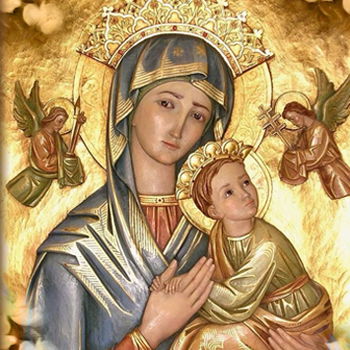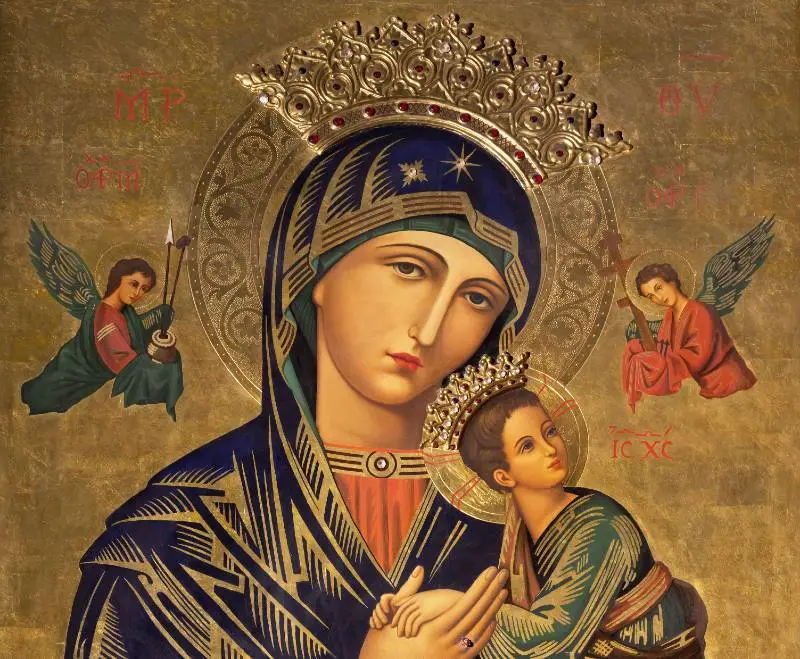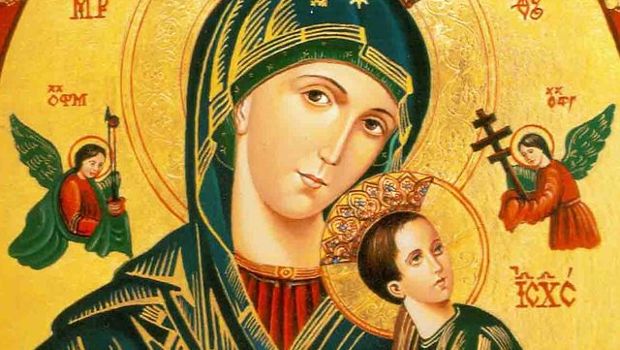Our Lady of Perpetual Help Patroness of Haiti

The miraculous icon of Our Lady of the Perpetual is well before the discovery of America.
Having this Marian invocation as the patroness of their congregation, the Redemptorist Fathers took her to their missions in Haiti. A sanctuary was built for her in Béle-Aire, near Port-au-Prince.
In 1883, a terrible smallpox epidemic struck the country. The devotees turned to Our Lady of Perpetual Help and made a novena to her. The epidemic miraculously ceased and it was decided to name her patroness of the country, and in 1993 the centenary of the miracle and the naming of the Virgin as patroness was celebrated with great rejoicing. Pope John Paul II visited Haiti for this celebration and placed the country under the protection of Our Lady of Perpetual Help. Haitians also have great devotion to Our Lady of the Assumption.
Our Lady of Perpetual Help
The original icon is on the main altar of the Church of St. Alphonsus, very close to the Basilica of Santa Maria Maggiore in Rome.
The icon of the Virgin, painted on wood, 21 by 17 inches, shows the Mother with the Infant Jesus. The Child observes two angels showing him the instruments of his future passion. He clings tightly with both hands to his Blessed Mother who holds him in her arms. The painting reminds us of the divine motherhood of the Virgin and her care for Jesus from his conception until his death. Today Our Lady takes care of all her children who come to her with complete trust.
History
In the 15th century a wealthy merchant from the island of Crete (in the Mediterranean Sea) had the beautiful painting of Our Lady of Perpetual Help. He was a very pious man and devoted to the Virgin Mary. How the painting came into his hands is not known; was it entrusted to him for security reasons, to protect it from the Saracens? What is certain is that the merchant was determined to prevent the painting of the Virgin Mary from being destroyed like so many others that had already suffered such a fate. He packed his belongings, arranged his business and boarded a ship bound for Rome. En route a violent storm broke out and everyone on board expected the worst. The merchant took the picture of Our Lady, held it aloft, and asked for help. The Blessed Virgin answered his prayer with a miracle. The sea calmed and the ship arrived safely in the port of Rome.
The painting fell into the hands of a family
The merchant had a very dear friend in the city of Rome so he decided to spend some time with him before moving on. With great joy he showed him the painting and told him that someday the whole world would pay homage to Our Lady of Perpetual Help.
After some time, the merchant became seriously ill. Feeling that his days were numbered, he called his friend to his bedside and begged him to promise that, after his death, he would place the painting of the Virgin in a worthy or illustrious church for public veneration. The friend agreed to the promise but did not fulfill it to please his wife who had become attached to the image. But Divine Providence had not taken the painting to Rome to be the property of a family but to be venerated by the whole world, as the merchant had prophesied. Our Lady appeared to the man on three occasions, telling him that he must put the painting in a church, otherwise something terrible would happen.
The man argued with his wife to comply with Our Lady, but she mocked him, telling him he was a visionary. The man feared to displease his wife, so things remained the same. Our Lady, at last, appeared to him again and told him that, for his painting to leave that house, he would have to leave first. Suddenly the man became seriously ill and in a few days he died.
The wife was very attached to the painting and tried to convince herself that she would be more protected in her own home. Thus, day by day, she put off getting rid of the picture. One day, her six-year-old daughter came to her in a hurry with the news that a beautiful, glowing Lady had appeared to her while she was looking at the painting. The Lady had told her to tell her mother and grandfather that Our Lady of Perpetual Help wished to be placed in a church; and, if not, everyone in the house would die.
The little girl's mother was frightened and promised to obey the Lady. A friend, who lived nearby, heard about the apparition. She went to see the lady and ridiculed the whole thing. She tried to persuade her friend to keep the painting, telling her that if it were her, she would pay no attention to dreams and visions. Hardly had she finished speaking, when she began to feel such terrible pains, that she thought she was going to die.
Filled with pain, she began to invoke Our Lady for forgiveness and help. Our Lady heard her prayer. The neighbor touched the painting, with a contrite heart, and was instantly healed. She then proceeded to plead with the widow to obey Our Lady once and for all.
The widow agrees to hand over the painting.
The widow was wondering in which church she should put the painting, when heaven itself answered her. The Virgin appeared again to the girl and told her to tell her mother that she wanted the painting to be placed in the church between the Basilica of St. Mary Major and the Basilica of St. John Lateran. That church was the church of St. Matthew, the Apostle.
The lady hurried to meet with the superior of the Augustinians who were in charge of the church. She informed him about all the circumstances related to the painting. The painting was taken to the church in solemn procession on March 27, 1499. On the way from the widow's residence to the church, a man touched the painting and was restored the use of an arm that had been paralyzed. The painting was hung above the high altar of the church, where it remained for nearly three hundred years. Loved and revered by all in Rome as a truly miraculous painting, it served as a means of countless miracles, healings and graces.
In 1798, Napoleon and his French army took the city of Rome. His outrages were countless and his arrogance satanic. He exiled Pope Pius VII and, under the pretext of strengthening Rome's defenses, destroyed thirty churches, including St. Matthew's, which was completely razed to the ground. Along with the church, many venerable relics and statues were lost. One of the Augustinian Fathers, just in time, had managed to secretly carry off the painting. When the Pope, who had been Napoleon's prisoner, returned to Rome, he gave the Augustinians the monastery of St. Eusebius and later the house and church of St. Mary in Posterula. A famous painting of Our Lady of Grace was already placed in that church so the miraculous painting of Our Lady of Perpetual Help was placed in the private chapel of the Augustinian Fathers in Posterula. It remained there for sixty-four years, almost forgotten.
Finding of a Redemptorist priest
Meanwhile, at the Pope's request, the Superior General of the Redemptorists established their main headquarters in Rome where they built a monastery and the church of St. Alphonsus. One of the Fathers, the historian of the house, made a study of the area of Rome where they lived. In his research, he came across many references to the old Church of St. Matthew and the miraculous painting of Our Lady of Perpetual Help.
One day he decided to tell his brother priests about his research: The present church of St. Alphonsus was built on the ruins of St. Matthew's where, for centuries, a miraculous painting of Our Lady of Perpetual Help had been publicly venerated. Among those listening was Father Michael Marchi, who remembered serving Mass many times in the Augustinian chapel of Posterula when he was a boy. There in the chapel, he had seen the miraculous painting. An old lay brother who had lived at St. Matthew's, and whom he had often visited, had often told him stories about Our Lady's miracles and used to add: "Keep in mind, Michael, that Our Lady of St. Matthew's is the one in the private chapel. Don't forget that." Father Michael related to them all that he had heard from that lay brother. Through this incident the Redemptorists learned of the existence of the painting, yet they were unaware of its history and of Our Lady's expressed desire to be publicly honored in the church.
That same year, through the inspired sermon of a Jesuit about the ancient painting of Our Lady of Perpetual Help, the Redemptorists learned of the history of the painting and of Our Lady's desire that this image of hers be venerated between the Church of St. Mary Major and that of St. John Lateran. The Jesuit saint had lamented the fact that the painting, which had been so famous for miracles and healings, had disappeared without revealing any supernatural sign for the past sixty years. It seemed to him that this was because it was no longer on public display to be venerated by the faithful. He implored his listeners, if anyone knew where the painting was, to inform him what the Virgin wanted.
The Redemptorist Fathers dreamed of seeing the miraculous painting again exposed to public veneration and that, if possible, it would happen in their own Church of St. Alphonsus. So they urged their Superior General to try to get the famous painting for their Church. After some time of reflection, he decided to request the painting from the Holy Father, Pope Pius IX. He told him the story of the miraculous image and submitted his request.
The Holy Father listened attentively. He sweetly loved the Blessed Virgin and was glad that she was honored. He took out his pen and wrote his wish that the miraculous picture of Our Lady of Perpetual Help be returned to the Church between St. Mary Major and St. John Lateran. He also charged the Redemptorists to make Our Lady of Perpetual Help known everywhere.
Finally, the painting of Our Lady appears and is venerated.
None of the Augustinians of that time had ever known the Church of St. Matthew. Once they learned the story and the desire of the Holy Father, they gladly obliged Our Lady. They had been her custodians and now they would return her to the world under the guardianship of other custodians. Everything had been planned by Divine Providence in a truly extraordinary way.
At the request of the Holy Father, the Redemptorists gave the Augustinians a beautiful painting to replace the miraculous one.
The image of Our Lady of Perpetual Help was carried in solemn procession through the colorful and joyful streets of Rome before being placed on the altar, built especially for her veneration in the Church of St. Alphonsus. The joy of the Roman people was evident. The enthusiasm of the twenty thousand people who thronged the flower-filled streets for the procession bore witness to the deep devotion to the Mother of God. At all hours of the day, a number of people from all walks of life could be seen in front of the painting, imploring Our Lady of Perpetual Help to hear their prayers and to obtain mercy for them. Many miracles and graces were reported daily.
Today, devotion to Our Lady of Perpetual Help has spread throughout the world. Churches and shrines have been built in her honor, and archconfraternities have been established. Her portrait is known and loved everywhere.
Signs of the image of Our Mother of Perpetual Help
(known in the Byzantine East as the icon of the Mother of God of the Passion)Although its origin is uncertain, it is estimated that the portrait was painted during the thirteenth or fourteenth century. The icon appears to be a copy of a famous painting of Our Lady that was, according to tradition, painted by St. Luke himself. The original was venerated in Constantinople for centuries as a miraculous painting but was destroyed in 1453 by the Turks when they captured the city.
It was painted in a flat style characteristic of icons and has a primitive quality. All the letters are Greek. The initials beside the crown of the Mother identify her as the "Mother of God". The initials next to the Child "ICXC" stand for "Jesus Christ". The Greek letters on the halo of the Child: owu mean "He who is", while the three stars above the head and shoulders of Mary Most Holy indicate her virginity before childbirth, in childbirth and after childbirth.
The smaller letters identify the angel on the left as "St. Michael the Archangel"; the archangel holds the spear and the reed with the vinegar-soaked sponge, instruments of Christ's passion. The angel on the right is identified as "St. Gabriel the Archangel", holding the cross and nails. Note that the angels do not touch the instruments of the passion with their hands, but with the cloth that covers them.
When this portrait was painted, it was not common to paint haloes. For this reason the artist rounded the head and veil of the Mother to indicate her holiness. The halos and golden crowns were added much later. The golden background, symbol of eternal light, enhances the rather bright colors of the vestments. For the Virgin the maforion (veil-robe) is purple, a sign of the divinity to which she is united exceptionally, while the robe is blue, an indication of her humanity. In this portrait the Madonna is out of proportion to the size of her Son because it is -Mary- whom the artist wanted to emphasize.
The charms of the portrait are many, from the ingenuity of the artist, who wanted to make sure that the identity of each of the subjects was known, to the sandal hanging from the Child's foot. The divine Child, always with that expression of maturity that befits an eternal God on his small face, is dressed as nobles and philosophers used to dress in ancient times: tunic girded by a belt and cloak thrown over his shoulder. The little Jesus has an expression of fear on his face and with his two little hands he presses the right hand of his Mother, who looks before him with a recollected and thoughtful attitude, as if she were remembering in her heart the painful prophecy made to her by Simeon, the mysterious plan of redemption, whose suffering servant Isaiah had already presented.
In its double denomination, this beautiful image of the Virgin reminds us of the salvific centrality of the Passion of Christ and of Mary and at the same time of the succoring goodness of the Mother of God and of us.


